Slow Juicers
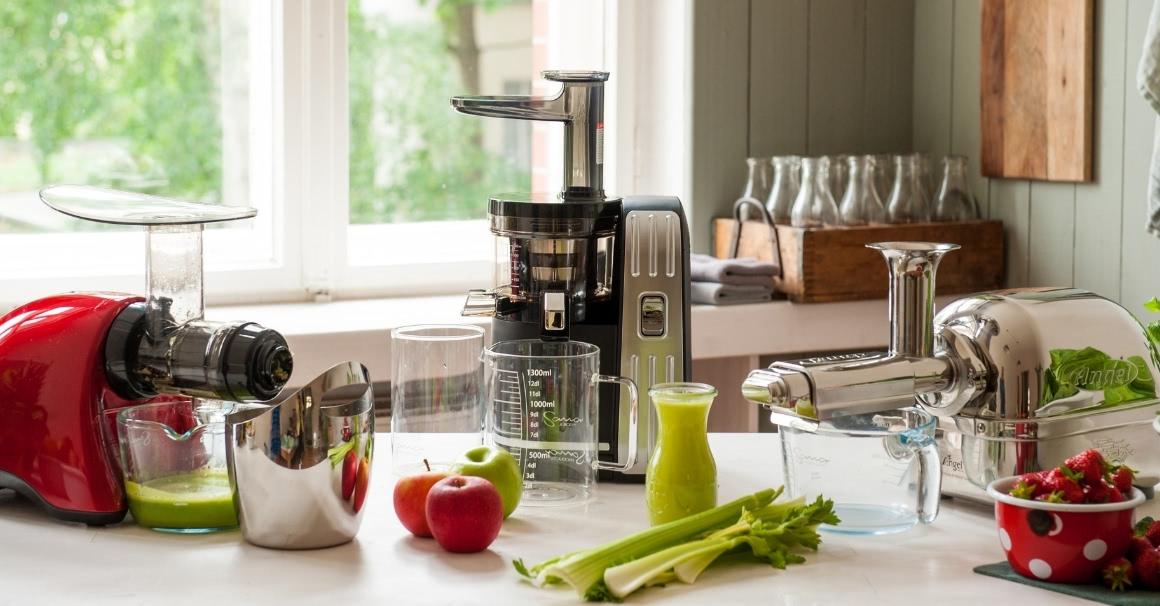
For us, almost no day goes by without preparing a freshly squeezed juice. Our favorite juices are celery juice and juices made from lots of greens and a little fruit. To ensure that your freshly squeezed juice tastes good, is as clear and particle-free as possible and also contains the maximum of nutrients and vital substances, we strongly recommend peparing it with a slow juicer.
See all our slow juicers ›
Slow juicers are characterized by a nutrient-preserving - slow - juicing of the ingredients. This is the only way to reduce oxidation to a minimum and ensure maximum nutrient density. Therefore, we have specialized on slow juicers and only sell devices that we can recommend without reservation. Whether you're new to the colorful world of juicing or already know what kind of juice you're particularly keen on (e. G. celery juice): Every model we offer has been tested extensively and is rated as a recommendable slow juicer.
Information about Slow Juicers
- Why slow juicers?
- The best Slow Juicers
- Slow Juicer for wheatgrass juice, spelt grass juice, barley grass juice
- Slow Juicer for celery juice
- Slow Juicers for fruits and vegetables
- Slow Juicers that are easy to clean
- Slow Juicer vs. Centrifugal Juicer
- Our Slow Juicers
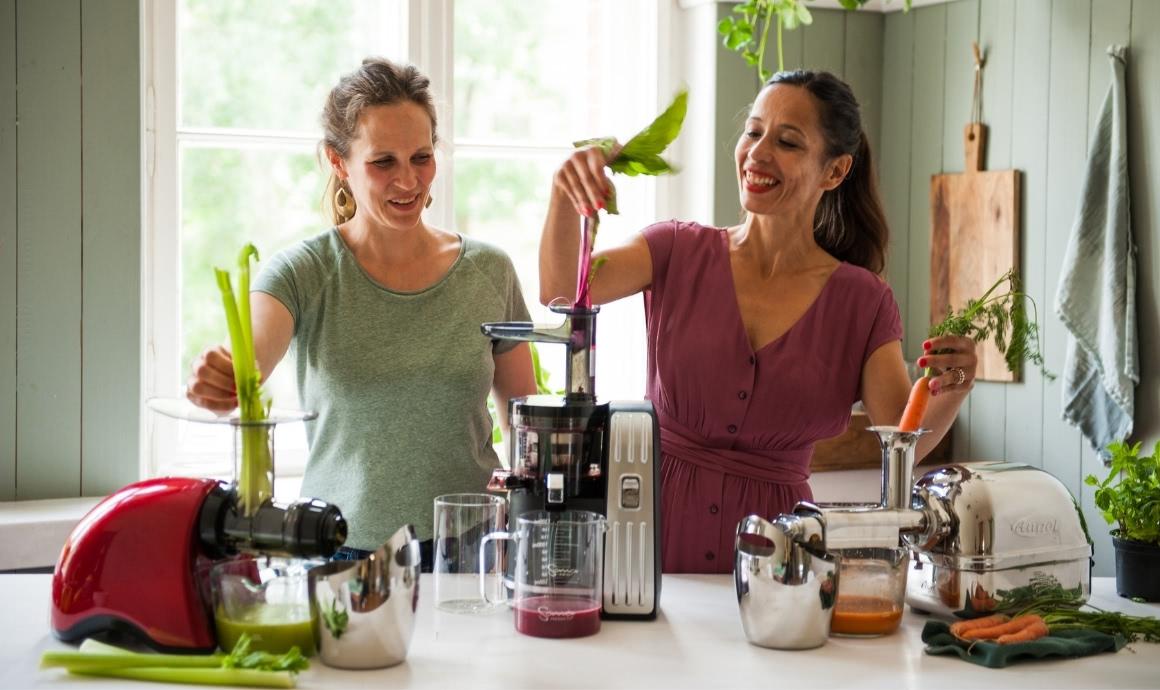
Why a Slow Juicer?
Slow juicers are the specialists when it comes to getting the maximum nutrients and vital substances out of the ingredients - they rotate slowly and gently. Four advantages of Slow Juicers:
Slow Juicer advantage 1: Less oxidation protects nutrients and flavor
Juicing is all about minimizing oxidation to preserve nutrients. Slow juicers rotate slowly - hardly any oxygen is absorbed during the juicing process. Not only does this keep valuable nutrients alive, but it also affects the taste.
Slow Juicer sdvantage 2: No heat generation
Nutrients are not only sensitive to oxygen, but also to heat. Since slow juicers work/rotate very slowly, heat development during the juicing process is prevented. This also explains the name that often is given to slow juicers: "cold juicer".
Slow Juicer advantage 3: Higher juice yield
Slow juicers squeeze the ingredients such as fruits, vegetables or leafy greens against a screen with tremendous pressure, extracting every drop of juice from the ingredients. This makes slow juicing an efficient and high-yield juicing process that is very cost effective in terms of ingredient use.
Slow Juicer advantage 4: Grasses can also be juiced
Slow juicers not only juice fruits and vegetables such as celery stalks, carrots, and apples, they can also process healthy leafy greens such as spinach, wild herbs and grasses. Centrifugal juicers reach their limits here due to their design. They may be able to juice celery with significant oxidation and heat generation, but processing grasses (e. G. wheatgrass) is not possible at all. In our tests, the juicing process generated enough pressure to explosively detach the lid of the juice drum from the device.
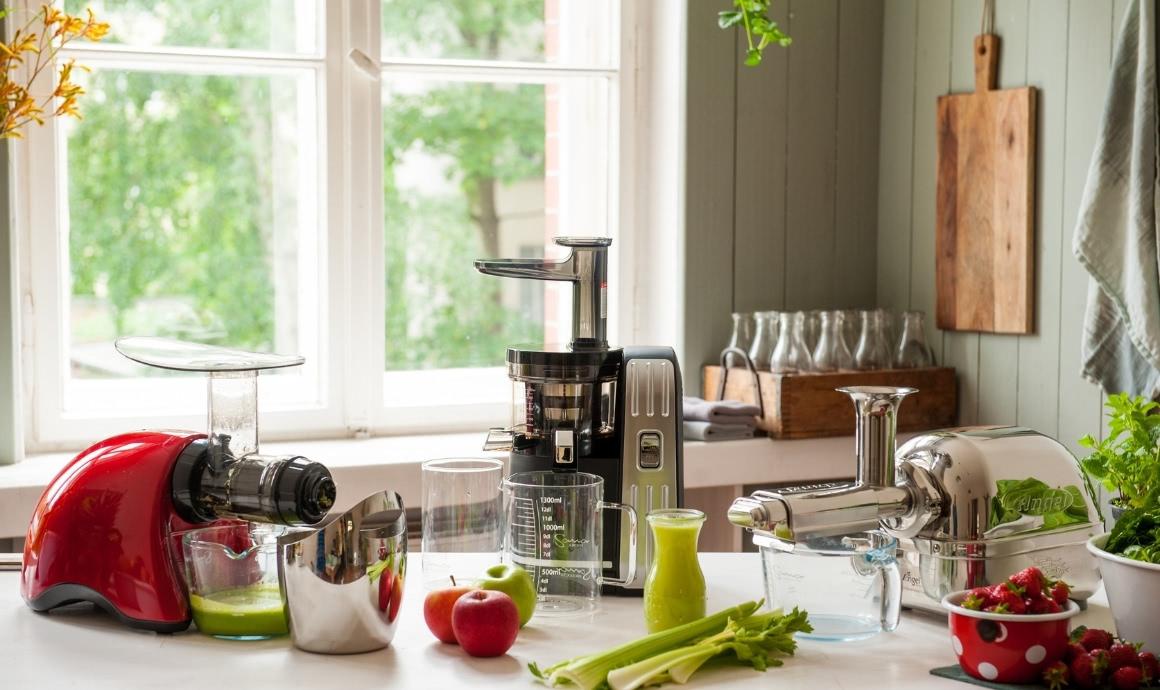
Top 3 Slow Juicer Ranking
We drink freshly squeezed juices every day, therefore we test slow juicers every day. To help you navigate through the slow juicer market as quickly as possible, we've created a ranking of the 3 best slow juicers in their respective categories. Because within the slow juicer world, there are three fundamentally different classes of devices:
- TOP 3 Horizontal Juicers with single auger
- TOP 3 Vertical Juicers
- TOP 3 Horizontal Juicers with twin auger
And it should be clear by now that not all slow juicers are the same. The different device classes have different strengths and weaknesses in the operation and preparation of freshly squeezed juices. Therefore, it is important to know what kind of juice you want to prepare and what you value before purchasing a device.
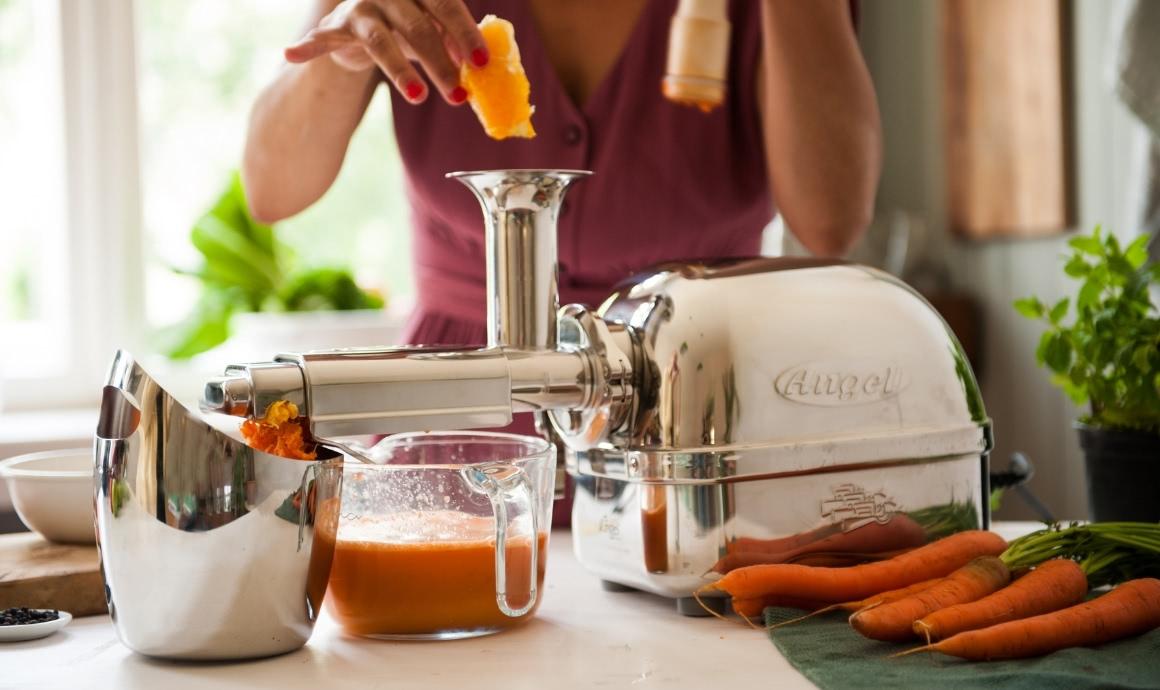
Top 3 Horizontal juicer with single auger: User-friendly all-rounder
If the slow juicer should be able to process all types of fruit, vegetables and leafy greens without any problems and be as easy to handle as possible, then horizontal juicers with one auger are the devices of choice. They are the most user-friendly all-rounders among slow juicers: Handling and cleaning are so easy that you can still enjoy your breakfast even if you already are 5 minutes late. We like to say that horizontal juicers with single auger are the best way to enter the world of juicing.
The juice yield is somewhat lower, the juice is not as fiber free as with a twin auger juicer and accordingly the juice does not have the same full bodied, round and smooth texture.
1st Place: Sana Juicer-707
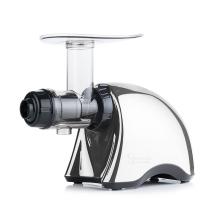
Proven over many years and our customers favorite - the Sana 707 convinces with its juice yield and very easy handling. The variety of colors and high-quality accessories also make the 707 the most popular model of all. Rightly in first place in this segment!
2nd Place: Sana 727 Supreme
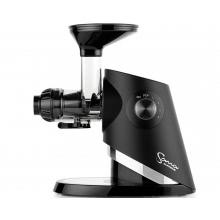
The Sana Supreme scores with an excellent juice yield, easy cleaning and its brushless industrial motor. This not only makes it run continuously, smoothly and quietly, but also saves energy and in the long term.
3th place: Omega Juicers MM900
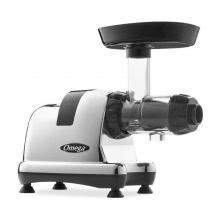
Regular Price: €449.00
Special Price €377.16
The celery juice expert par excellence, Anthony William, loves the MM900. It is optimized specifically for celery juice and produces an amazingly high juice yield. A fair price and the fact that it is very easy to clean make it a perfect everyday device.
Top 3 Vertical juicer: Compact specialists for fruit juices and soft ingredients
If juicing is primarily about fruits such as apples and pears, pineapples and berries, or water-rich vegetables such as cucumbers and tomatoes, vertical juicers are the specialists. Due to their design, pure fruit juices can be produced well, as gravity is more effective than with horizontal devices. Of course, mixed juices of fruit, leafy greens or root vegetables can also be prepared. However, vertical slow juicers are less suitable for juicing large quantities of fibrous ingredients such as celery or leafy greens. These ingredients cause the juice drum and screen to clog frequently.
Another advantage of the design: vertical juicers are more space-saving and take up less room in the kitchen than most horizontal juicers.
In terms of juice yield and juice quality, vertical juicers deliver good results. However, handling and cleaning effort are somewhat higher than with the user-friendly horizontal juicers with one auger - as there are simply more parts and a larger screen in use.
1st Place: Hurom H-320N/Hurom H-330P & Kuvings AUTO10
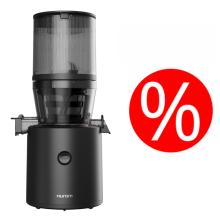
Regular Price: €599.00
Special Price €539.10
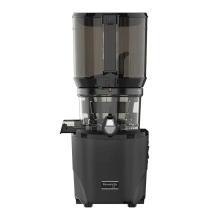
Regular Price: €699.00
Special Price €594.15
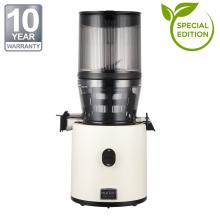
Regular Price: €629.00
Special Price €562.34
The first place goes to three slow juicers that have enriched juicing with maximum comfort and time savings - the Hurom H-320N and its technically identical successor - the Hurom H-330P - and the Kuvings AUTO10. The latter almost resembles a juice vending machine - once filled, it can produce over a liter of juice without any effort on your part! It doesn't get easier than this with a nutrient-preserving slow juicer at the moment.
2nd Place: Kuvings REVO830
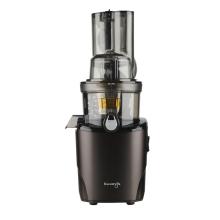
Regular Price: €649.00
Special Price €549.00
In second place on our best list is the Kuvings REVO830. It has impressed us with its very high juice yield - as good as no other vertical juicer!
3rd Place: Hurom H-AA
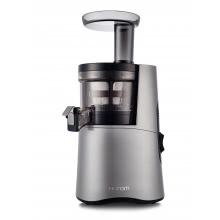
Regular Price: €399.00
Special Price €349.00
With a slight distance to the second place, the Hurom H-AA follows in third place. This reliable vertical juicer impresses with good juice yield, compact dimensions, and an attractive price-performance ratio.
Top 3 Horizontal juicer with twin auger: Specialists for green juices and root juice
If juicing is primarily about producing green juices from fibrous ingredients such as leafy greens, celery and grasses, or juice from carrots, beet and parsnips, then a horizontal juicer with twin auger is likely to come into question. The juice ingredients are squeezed to the last drop by two interlocking augers. The result: you get maximum juice yield and maximum flavor experience. In our experience, all juices taste a tad more aromatic, balanced and full-bodied with the same amount of ingredients.
When making juices exclusively from soft or very ripe fruit such as pineapple, mealy apples and pears, or berry fruit, twin auger juicers do have some difficulties. The reason: The ingredients jam the hopper, foam starts building easily and the juicing process takes a bit longer. In addition, cleaning after juicing is more time-consuming than with horizontal juicers with only one auger.
1st Place: Angel Juicer
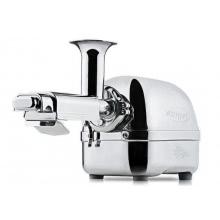
Regular Price: €1,449.00
Special Price €1,049.00
The Angel Juicer is actually in a class of its own. Due to its high-quality workmanship and appearance, as well as the sensational juice taste. The Angle Juicer is a must have for all green gourmet juice lovers.
2nd Place: Greenstar 5
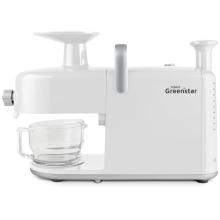
For those who want a twin-gear juicer but have a budget of no more than €1000, we recommend the Greenstar 5. The latest Greenstar model is the improved successor to the Greenstar Pro - more robust, durable, and even more convenient - and therefore well-deserving of second place.
3th Place: Greenstar Pro
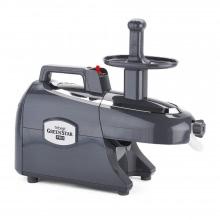
Regular Price: €899.00
Special Price €832.34
Third place goes to the Greenstar Pro. Also equipped with metal rollers and a 12-year warranty, it is even more affordable than the Greenstar 5.
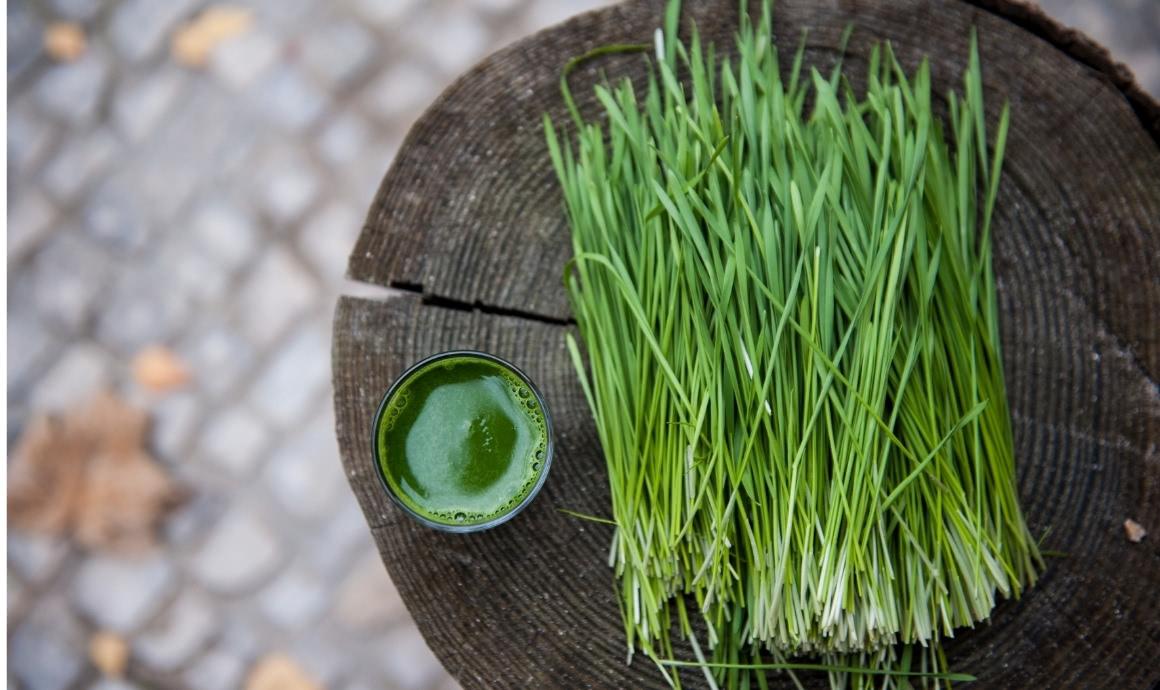
Slow juicer for wheatgrass juice, spelt grass juice, barley grass juice
If you have read the paragraph "TOP 3 Twin auger Slow Juicers", you can skip this part. Without a doubt, twin augers are best for all grasses. Once you start juicing, you will notice that the twin auger models are actually designed for juicing grasses. No wonder, the twin auger juicers produce a much higher juice yield than other models. Horizontal single auger juicers can also process grasses, but will never be as efficient in terms of juice yield. We don't recommend vertical juicers for producing grass juices in larger quantities, as the grass gets stuck in the housing. For those who want to enjoy freshly squeezed grass juice regularly, purchasing a twin auger slow juicer definitely makes sense. For those who only want to process wheatgrass or barleygrass from time to time, the single auger juicers might be a more cost-effective alternative.
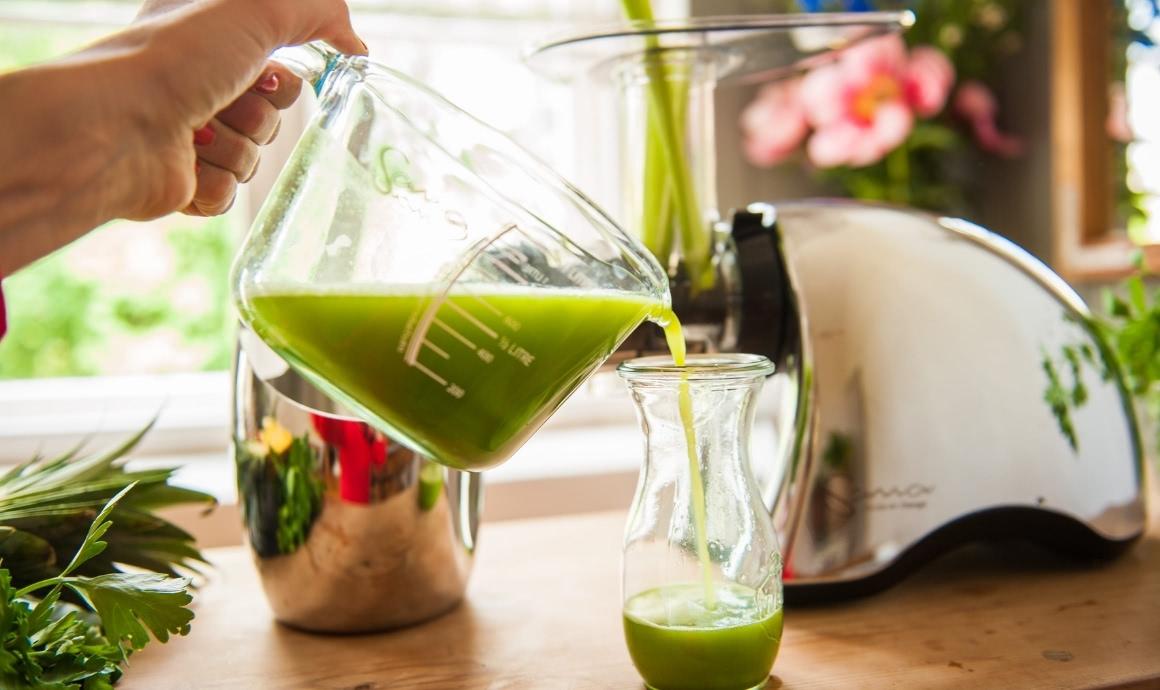
Slow juicer for celery juice
Celery juice can be produced easily with any juicer, even with a centrifugal juicer. However, if you want to enjoy a chunk-free and nutrient-dense celery juice, you should use a slow juicer. The Angel juicer simply outperforms all other juicers, but there are some single auger slow juicers that can almost achieve the same juice yield (see celery juice test). In terms of handling, however, horizontal slow juicers with one auger are much easier to use - especially when it comes to cleaning. Therefore, our current general recommendation for celery juicers: Single auger horizontal juicers.
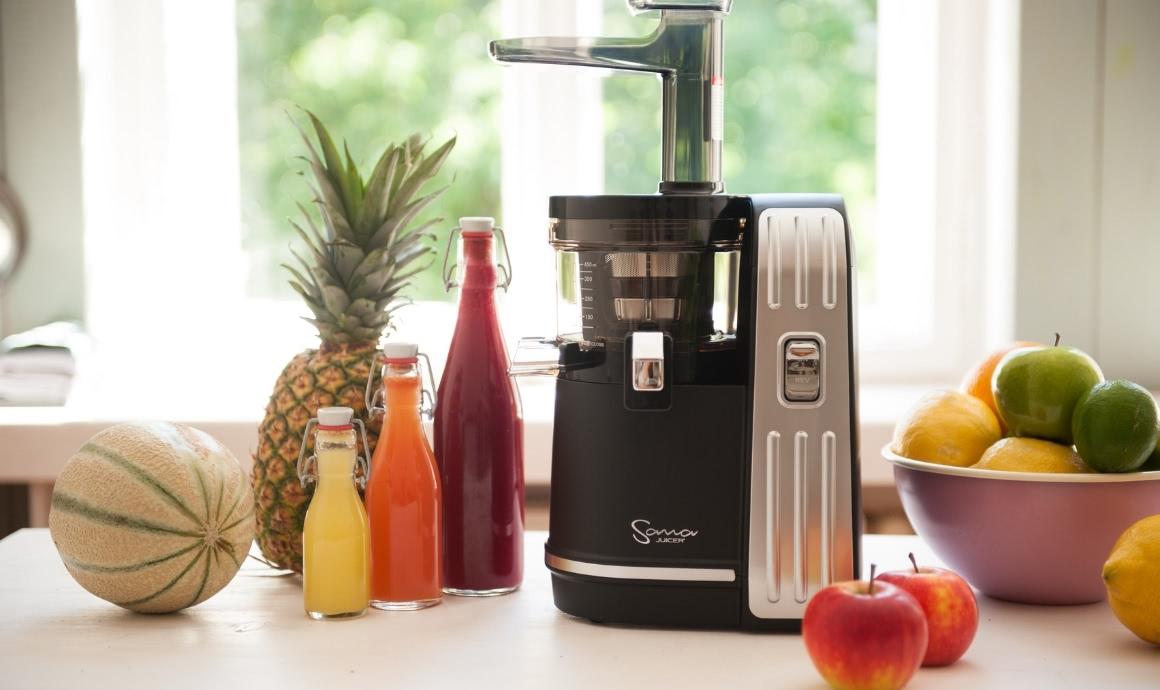
Slow juicer for fruits and vegetables
Even though we haven't done any exact juice yield tests on this, our experience can already tell that the twin auger juicers are less suitable for this discipline. Due to the hopper, the ingredients have to be cut into very small pieces and juicing produces a lot of foam. This is much more convenient with the single auger juicers. There is not as much foam and thus each juicing process is somewhat faster. However, the vertical juicers perform best here. As already shown in the conclusion to the slow juicer best list above, the vertical slow juicers use the help of gravity when preparing fruit juices or juices with a large proportion of soft or watery ingredients such as tomatoes and cucumbers, grapes, mealy apples and pears or cucumbers.
Slow juicers that are easy to clean
Of course, cleaning must also be mentioned when it comes to slow juicers. Especially if you want to "quickly" squeeze yourself a ginger shot, it is important to know whether the slow juicer can easily be cleaned or not. If you know cleaning will take too long, you won't do it at all. This means you miss out on the immune booster for in between and a more cleaning-friendly device would have led to much more intensive use.
In any case, the easiest to clean are the single auger slow juicers, like the Sana Juicer-707:
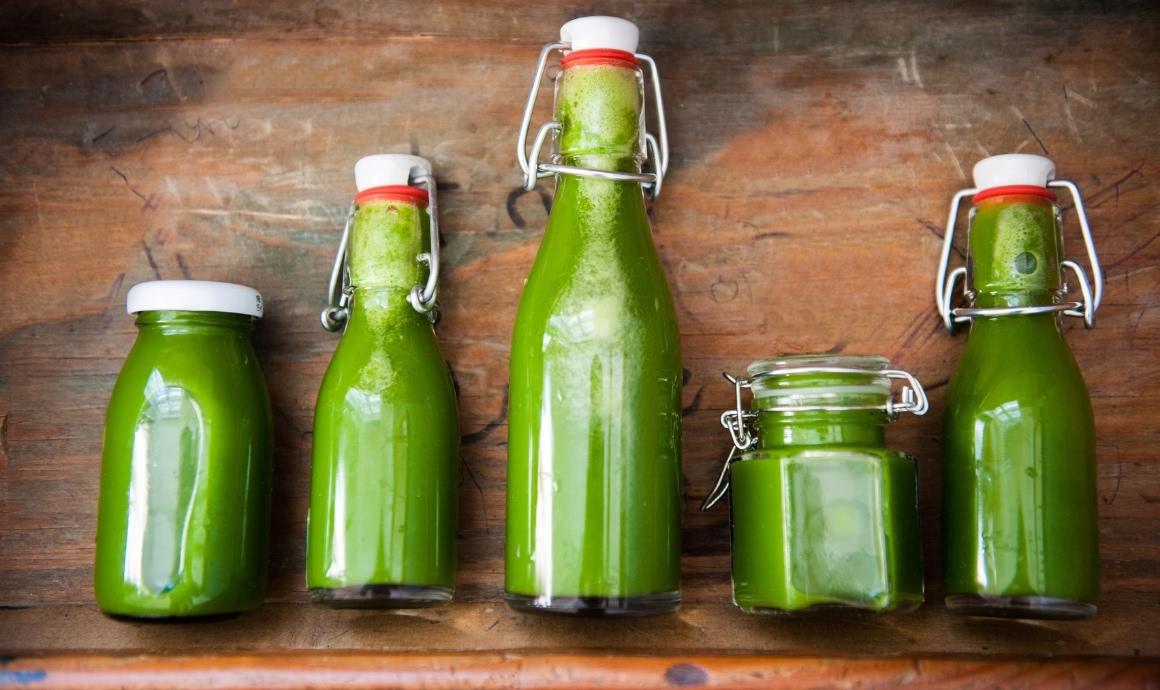
Slow Juicer vs. Centrifugal Juicer
Centrifugal juicers rotate quickly. Accordingly, larger quantities can be juiced in a shorter time. However, this generates significantly more heat and, above all, oxidation. Both lead to the juice losing nutrients and vital substances. The oxidation can be recognized by a grayish color of the juice, it is also noticeable in terms of taste. In addition, the juice yield is often lower, and the juice may still contain solid pieces. A slow juicer is gentle on nutrients, achieves a higher juice yield and, above all, produces a better tasting juice.
If you have any questions about our Slow Juicers, write us here:
Our slow juicers
-

Tribest Shine
incl. VAT, plus shipping costsRegular Price: 199.00
Special Price €176.78
Shipping to DE from 49.- free of charge -
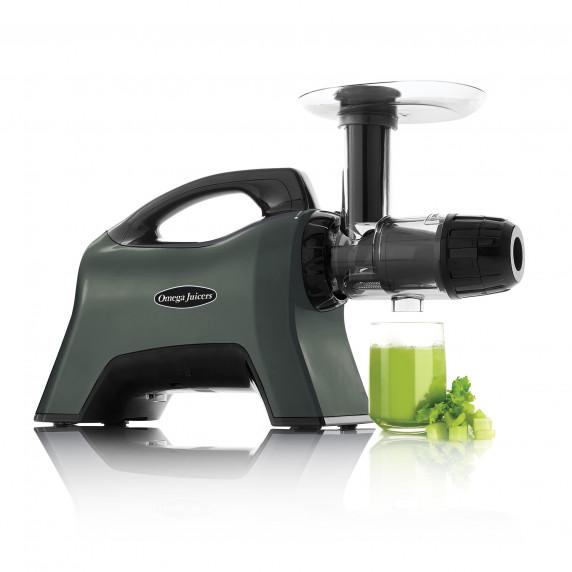
Omega Juicers MM1500
incl. VAT, plus shipping costsRegular Price: 549.00
Special Price €499.00
Shipping to DE from 49.- free of charge -

Hurom H-320N
incl. VAT, plus shipping costsRegular Price: 599.00
Special Price €539.10
Shipping to DE from 49.- free of charge -

Kuvings REVO830
incl. VAT, plus shipping costsRegular Price: 649.00
Special Price from €549.00
Shipping to DE from 49.- free of charge -

Kuvings AUTO10
incl. VAT, plus shipping costsRegular Price: 699.00
Special Price €594.15
Shipping to DE from 49.- free of charge -

-

Hurom H-330P
incl. VAT, plus shipping costsRegular Price: 629.00
Special Price from €562.34
Shipping to DE from 49.- free of charge -

Angel Juicer 5500 / 7500 / 8500S
incl. VAT, plus shipping costsRegular Price: 1,449.00
Special Price from €1,049.00
Shipping to DE from 49.- free of charge -

Omega MM900
incl. VAT, plus shipping costsRegular Price: 449.00
Special Price €377.16
Shipping to DE from 49.- free of charge -
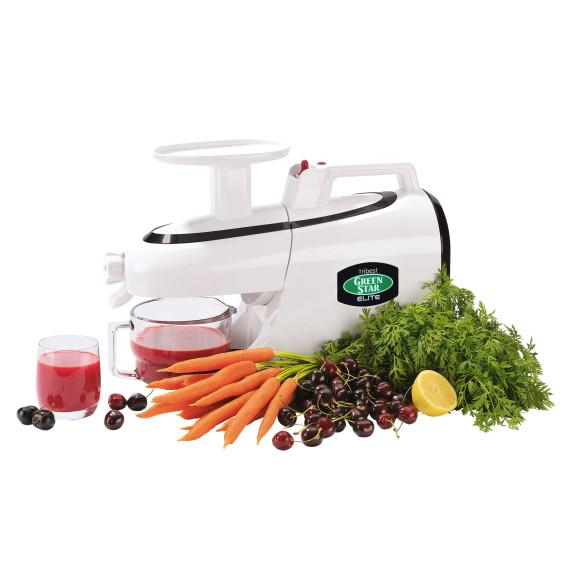
-

-

Hurom H-AA
incl. VAT, plus shipping costsRegular Price: 399.00
Special Price €349.00
Shipping to DE from 49.- free of charge -
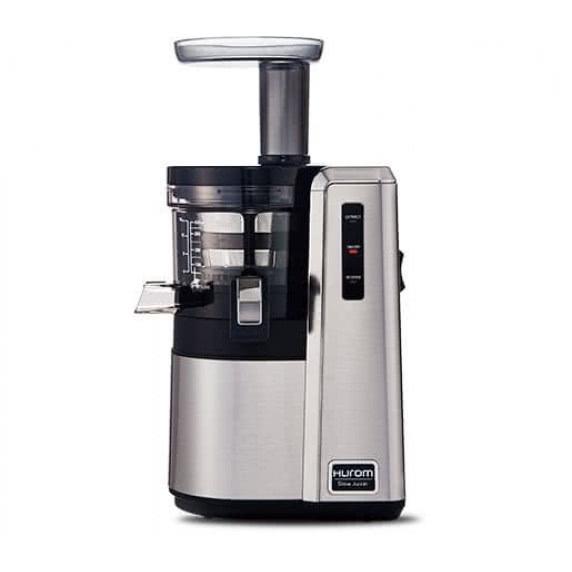
-
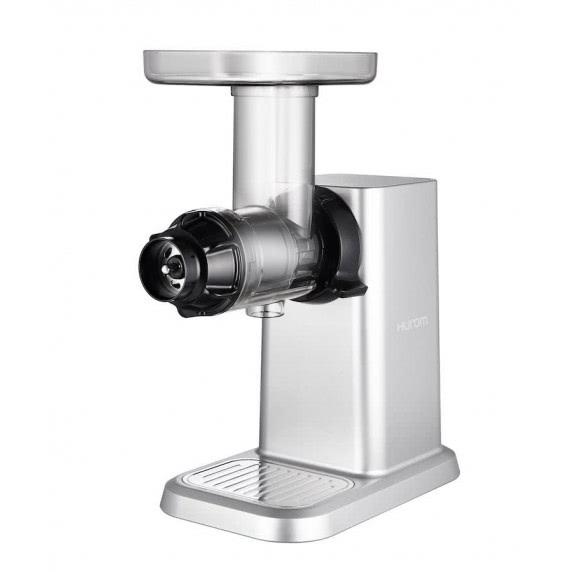
-
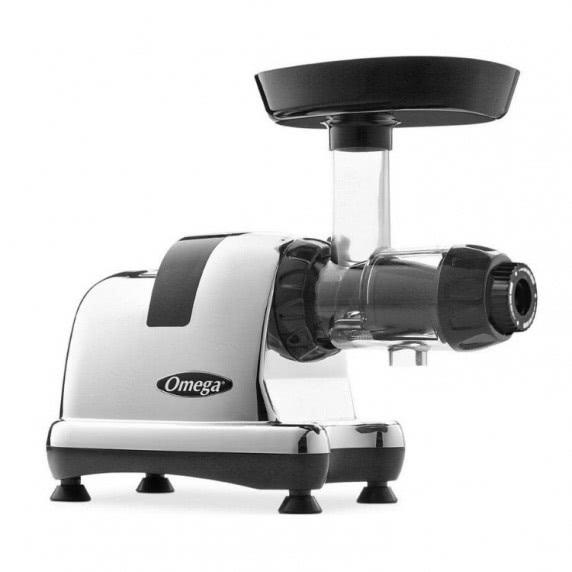
-

Greenstar Pro
incl. VAT, plus shipping costsRegular Price: 899.00
Special Price €832.34
Shipping to DE from 49.- free of charge



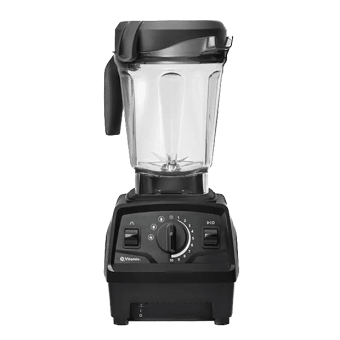




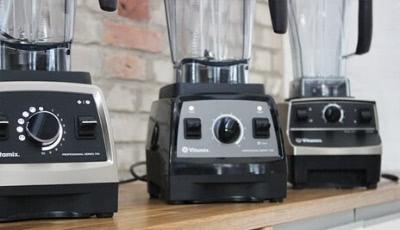
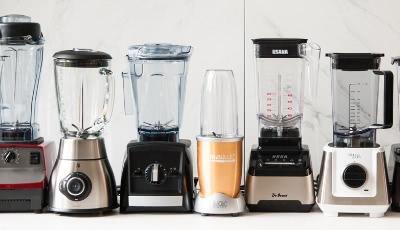

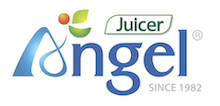





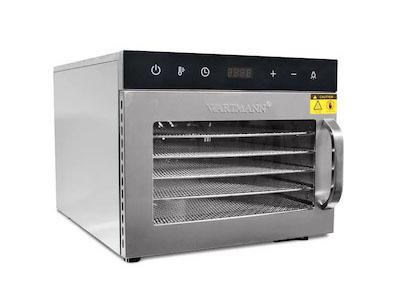
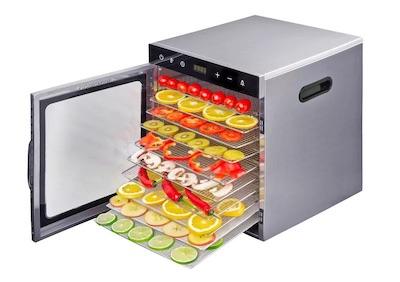
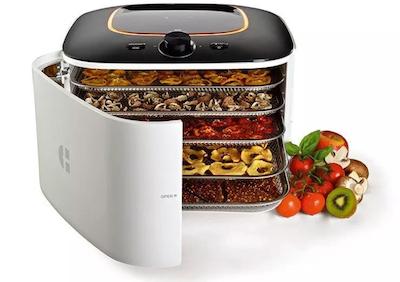
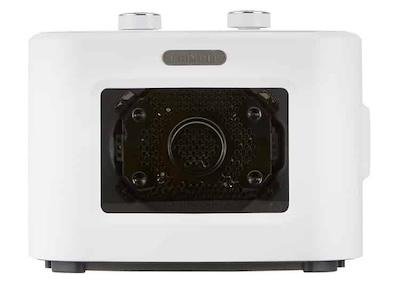

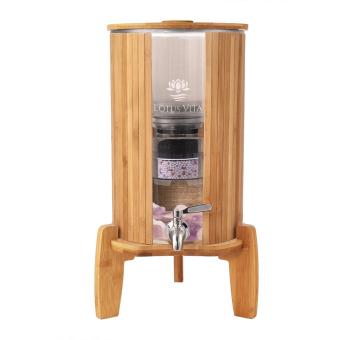
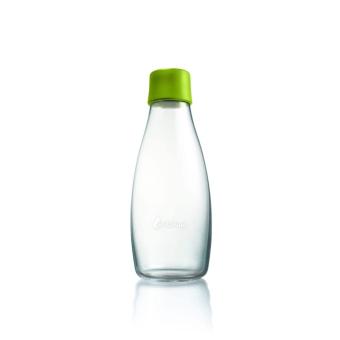
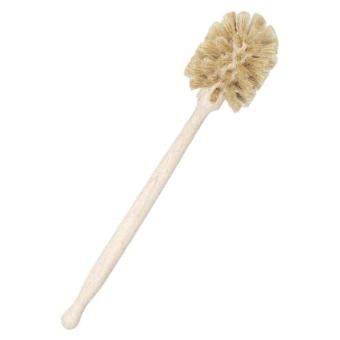
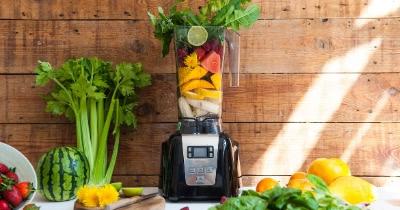
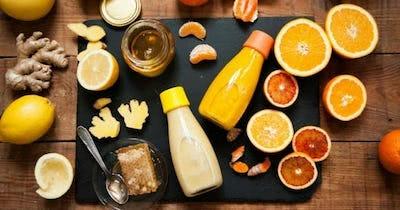
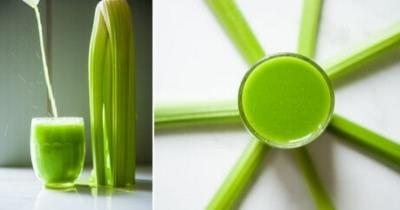
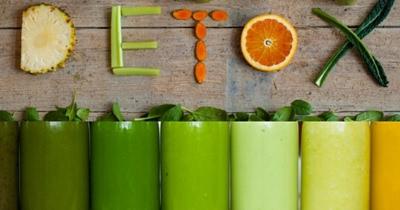

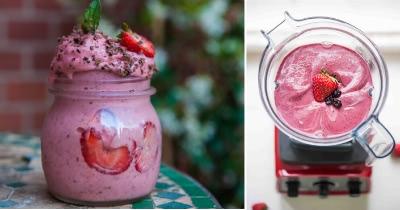
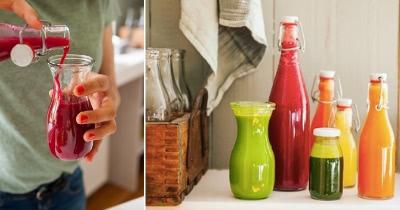
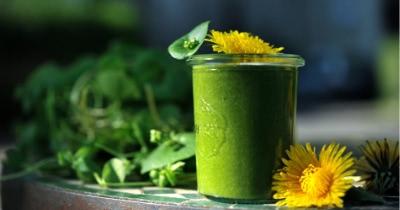
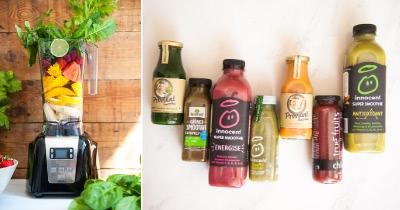
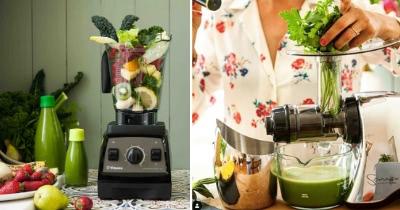
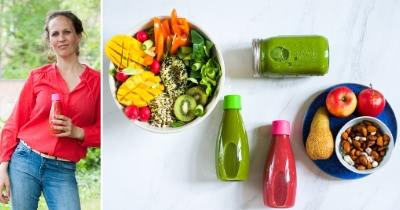




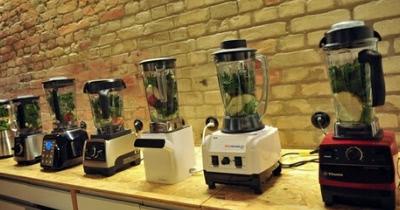
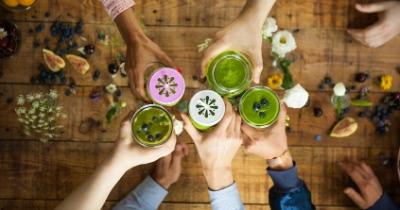


Add comment
202 | Comment(s)
I have a KitchenAid and am considering getting the juicer attachment. I am very happy with my KitchenAid and the motor is practically already there. Have you tested this device? What do you think?
Warm regards
thank you for your inquiry. We have not tested the KitchenAid with the juicer attachment yet. This is definitely a vertical juicer attachment. In terms of the motor power, juicing with it using the KitchenAid should not be a problem. How clear and particle-free the juice turns out, and how good the juice yield is, cannot be predicted without testing.
Best regards,
Carla
I was recommended the Hurom M100 because it is not just a slow juicer, but also a blender with many functions. What do you think about this device?
Thank you very much,
Björn
thank you for your inquiry. We have not included the Hurom M100 in our shop because it did not convince us in producing clear, full-bodied juices or creamy-fine green smoothies. The individual devices are more powerful in their respective disciplines and deliver better results in juice or smoothie quality.
Best regards,
Carla
I mainly want to make green juices, including ones from wild herbs like ground elder, dandelion, etc. To prevent it from becoming too bitter, I would also add some fruit to the juicer. Which device would be best suited for this?
Thank you.
Warm regards,
Sebastian
I would definitely recommend a horizontal juicer like the Sana Juicer 707. Of course, the Angel Juicer is also a great option, especially for juicing herbs and grasses. However, it is much more expensive.
If you have any further questions, feel free to reach out again!
Best regards,
Carla
Would you need to boil the juice again because of the oxalic acid?
I imagine it would be delicious as a spritzer.
thank you for your question.
I don't have any personal experience with juicing rhubarb. I imagine the juice to be quite sour, and as you mentioned, rhubarb is said to contain a lot of oxalic acid. Therefore, I would only consume it in small doses.
Please do let us know how your rhubarb juice turned out and how you combined it.
Best regards,
Carla
I would like to get a juicer for green juices. My budget is around 500 €. The device should also be space-saving. What can you recommend?
Best regards,
Caroline
Thank you for your inquiry.
I would recommend the Sana Juicer 606 or the Sana Juicer 707 to you. They are within the price range you have set. Both devices are excellent for making green juices, especially celery juice.
If you have any further questions, feel free to reach out!
Best regards,
Carla
since I prefer juicing all kinds of vegetables (including celery), fruits, and ginger (and sometimes even passing through a sorbet/ice cream), I came across the Sana Juicer 707 (also because that's the max budget for me.) However, I notice that the rotations per minute are significantly higher than in other devices. Wouldn't that have a negative impact on the final result? Are there any good alternatives under 500 euros?
thank you very much for your comment and your question regarding the Sana Juicer 707. The Sana 707 is absolutely gentle on nutrients when juicing ingredients - spinning at 63-75 rotations per minute, it falls in the middle range. The Angel Juicer, known to many juice enthusiasts as the top Slow Juicer, operates at 82 rotations per minute, for example. So no need to worry. The Sana 707 is one of our absolute customer favorites - easy to handle and great for all juice preparations. In this price range, I can't recommend a better alternative!
Best regards,
Carla
I can't see any additional benefits of the Hurom H-AA compared to the Sana 707. It is also much easier to clean than the Hurom H-AA, which I personally find important when juicing regularly.
Much love,
Carla
Today I am reaching out to you in the hopes of receiving advice regarding the Hurum Slow Juicer and possible alternatives. I currently own a juicer that is ten years old and features two twin presses. My preference lies in juicing vegetables such as beets, carrots, spinach, celery, and cucumbers. I rarely prepare fruit juice.
However, I have been using my juicer less frequently lately due to the time-consuming cleaning process and the physical effort required to press the vegetables. Nevertheless, I would like to start drinking more juice again and wonder if there are now better and more modern models available that are easier to clean and require less physical effort for juicing. It is particularly important to me that gentle processing is ensured to retain vitamins and nutrients.
During my research in your shop, I came across the Hurum Slow Juicer and also watched the comparison video with the Kuvings. Additionally, I noticed that you recommend the Green Star, which, however, appears to be similar to my current model.
Could you, based on my needs for modernity, easy cleaning, and gentle processing, make a recommendation? I would appreciate any advice and look forward to your response.
Thank you in advance and best regards from Pfalz.
Thank you for your inquiry. To answer your questions more accurately, I would like to know which slow juicer you are currently using. The Hurom Slow Juicers - Hurom H-320N and Hurom H-330P - effortlessly extract juice thanks to their large feeding chamber. The Kuvings AUTO10, with an even larger feeding chamber, almost resembles a juice vending machine. No effort is required, unlike a horizontal slow juicer with twin gears. Simply chop all ingredients a bit, fill the chamber, and let the slow juicer do its magic. All mentioned slow juicers preserve nutrients but may not be as efficient in juice extraction as the Angel Juicer or Greenstar models. You can check how each model performs, for example, when making freshly pressed celery juice here.
Cleaning the vertical juicers from Hurom and Kuvings should be a bit easier compared to your slow juicer with twin gears. The design of these devices results in the highest cleaning effort. Horizontal slow juicers with a single auger, like the Sana Juicer 707, are the easiest to clean. With the Sana 707, you can also extract nutrients from all the ingredients you mentioned; the juice yield is similar to Hurom or Kuvings. However, you need to stand by and feed the ingredients gradually, applying some pressure, especially with harder ingredients.
Feel free to reach out if you have any more questions.
Best regards,
Carla
Best regards,
Carla
I would like a slow juicer that can really juice everything. From celery, fruit, vegetables to nuts, and that is easy to clean. What could you recommend for me?
Kind regards,
Thank you,
Elif
thank you for your inquiry. I would recommend the Sana Juicer 707 to you. With this slow juicer, you can make all kinds of freshly pressed juice as well as nut milk. Additionally, the Sana 707 is very easy to operate and, most importantly, to clean. This is why it is one of our absolute customer favorites! If you have any further questions, feel free to contact us.
Best regards,
Carla
I recommended the Sana 707 to you because it can juice all ingredients well and reliably, and you had asked for a device that is easy to clean. The Angel Juicer is definitely more time-consuming to clean than the Sana 707. It is the perfect device for making green juices like celery juice, all types of grass juice, or juices from roots such as carrots, beetroot, or ginger - so fibrous or solid ingredients. When juicing watery or very soft fruits or vegetables like pineapples, pears, oranges, or cucumbers, an ingredient blockage quickly forms in the feeding chute or it foams up. You just need a little more patience and time until these ingredients are juiced. The juice result is fantastic in terms of flavor - rich and clear. If you have any further questions, feel free to reach out again!
Best regards,
Carla
We are a family of 5 and unsure about purchasing a slow juicer. We have the following requirements: Squeezing celery, parsley, coriander and ginger daily for 2 adults. 3 children also make juice themselves approximately 4 times a week using carrots, lettuce, cucumbers, apples, and frozen blueberries.
We are considering between the Hurom H-330P or a horizontal juicer with 1 auger...what would you recommend?
Thank you, Kathrin
Thank you for your inquiry. Since you want to juice both fibrous ingredients like celery and herbs as well as (water-rich) fruits, I would recommend the Kuvings AUTO10 for you. While you can also juice all the mentioned ingredients with the Hurom H-330P and its technically identical predecessor model - the Hurom H-320N, if you also want to make very green juices, then I would give preference to the Kuvings AUTO10.
Feel free to reach out if you have any further questions!
Best regards,
Carla
I would like to buy a slow juicer that can make ginger-turmeric shots, juice grasses and celery very well, but also use vegetables and fruits as ingredients for the grass juices. It's important to me that it's easy to use and easy to clean. I particularly want the juice to only run along stainless steel parts/glass, and not plastic. I'm also a bit skeptical about Tritan and these new materials that are made without BPA but from some still untested substances... The Angel Juicer is supposed to be great, but €1,200 is too much for me. It was recommended to me, I don't even know if you have it. Is there something around €600 that could fit my needs? Is there one whose parts can go in the dishwasher?
Thank you very much in advance for your feedback!
Kind regards,
Vanessa
Thank you for your inquiry. Yes, we sell the Angel Juicer - you can find it here. Alternatively, the Sana 929 Ultimate Juicer could also be an option - also made entirely of stainless steel and slightly easier to clean than the Angel Juicer - but priced in the Angel Juicer league. If you are interested in this device, it's best to sign up in the registration box for the launch, and we will automatically notify you when the device is available. Those are the two devices made of stainless steel. Since you also want to make grass juices, the Angel Juicer would be the better choice as it extracts grasses even more efficiently than the Sana 929.
All other slow juicers are mostly made of plastic. A compromise would be the Greenstar Pro or the Greenstar 5 - both slow juicers have stainless steel press rollers. The Greenstar 5 is the successor to the Greenstar Pro - if you are interested in this model, also sign up in the registration box on the page so we can notify you when it is available for sale.
Regarding dishwasher cleaning: We generally advise against it. Especially with the Angel Juicer, the sieve housing must be cleaned manually with the corresponding brush and scraper.
If you have any further questions, feel free to contact us.
Best regards,
Carla
I'm currently looking for a slow juicer for celery juice and ginger shots. The Sana Juicer 707 is often mentioned here, but I'm a bit skeptical about the plastic auger. Is it really that durable?
I'm more of a fan of stainless steel augers like the ones in the Greenstar Pro (which I find ugly) and the Angel Juicer (which is probably worth the money but quite expensive). Is there perhaps another slow juicer with a stainless steel auger that is good?
vielen Dank für Deine Anfrage.
Der Sana 707 ist nicht nur ein Kundenliebling, sondern wird auch sehr von unserem Kundendienst geschätzt, weil er so robust ist und alle Arten von Saft zuverlässig herstellt. Natürlich auch Selleriesaft und Ingwer-Shots.
Evtl. könnte die neue Greenstar 5 etwas für Dich sein. Sie ist der verbesserte Nachfolger von der Greenstar Pro und ebenfalls mit Edelstahl-Presswalzen ausgestattet. Falls Dich das Gerät interessiert, dann trage Dich am besten in die Interessenten-Box ein. Sobald die GS5 lieferbar ist, erhältst Du automatisch eine Nachricht von uns.
Viele Grüße,
Carla
thank you very much for the quick response. The Greenstar 5 is indeed an interesting alternative. But I can't convince my better half to wait another 2 months. Haha. Therefore, it will probably be the Sana Supreme 727, especially because of the brushless DC motor (since we prepare our juices quite early in the morning and don't want to wake up everyone in the house) and the juice yield for celery.
Best regards,
Sebastian.
all right. The Sana Supreme is certainly a top-quality device too! I wish you a lot of joy while juicing.
Best regards,
Carla
from when will the Hurom H330P Slow Juicer be available with you?
Thank you and kind regards
Best regards,
Calra
thank you for your inquiry. We do not offer the Hurom H-400 because the juices made with it are not nearly as clear and particle-free as we envision. In terms of this aspect, the H-400 cannot compete with the Angel Juicer or any of the Sana juicers we sell in our shop. When the juices are not clear, it also affects the taste of the juice, as the ingredients are not as well extracted.
The reason for this lies in the screen: The Hurom H-400 has a coarser plastic insert instead of a fine stainless steel screen.
Best regards,
Carla
thank you for the many tips and recipes.
Today, I have a request: Can you recommend a juicer for preparing ginger juice?
Thank you in advance and all the best.
Regine Lorenz
thank you for the lovely feedback on our recipes!
If you only want to make ginger juice, I would recommend the Sana Juicer 707. It produces clear ginger juice with good yield. Another great advantage of the Sana 707 is that it is easy to use and very straightforward to clean. And of course, you can also make other types of freshly squeezed juices with it.
For excellent yield in ginger juice, horizontal juicers with twin gears like the Angel Juicer and the Greenstar Pro are highly recommended. The twin gear juicing system extracts every last drop from the ingredients, resulting in an even more flavorful juice. However, these slow juicers are more time-consuming to clean and naturally come at a higher price point.
If you have any further questions, feel free to reach out!
Best regards,
Carla
Thank you and best regards.
thank you for your inquiry. In our shop, we only include slow juicers that meet our standards on all levels - especially in terms of their performance and the manufacturer's service. Regarding the latter point, it is important to us, for example, whether the manufacturer offers spare parts so that the devices can be used in the long term. So if a brand or model is not represented in our shop, it means that it fell short in one of the mentioned aspects.
Best regards,
Carla
I miss the Hurom H400 on your website. Will there be more detailed information available soon?
thank you for your inquiry. We have decided not to include the Hurom H-400 in our range of slow juicers. It does not have a fine screen, which means that the juices are not nearly as clear and particle-free as, for example, with the Hurom H-320N. This also affects the taste of the juice, as the ingredients are not as effectively extracted.
Best regards,
Carla
I am considering the Kuvings Auto10 and Kuvings Revo830 juicers and I'm trying to decide which one to purchase. I primarily want to make fruit juices and occasionally green juices. Are there any differences in the design, aside from the feeding chute? For example, in terms of motor power or the juice auger?
Best regards
thank you for your inquiry. Both juicers press the juice ingredients at a slow speed of 40-50 rotations per minute to preserve as many nutrients as possible. The Kuvings AUTO10 produces a clearer, particle-free juice consistency compared to the Kuvings REVO830. Although the juicer tops have different designs, both devices have similar dimensions. In terms of handling, we prefer the AUTO10 because of its generous hopper, which allows for almost automatic juicing. Simply fill the AUTO10 with juice ingredients and let it juice without any further intervention. Your juice is ready. With the REVO830, you need to be present during juicing as you have to reload the ingredients repeatedly through the wide or narrow opening.
If you have any further questions, please feel free to ask.
Best regards,
Carla
But I'm not sure which one to choose. If I want to make green juices with cabbage, broccoli, kale, turmeric, but also fruit juices with apples, oranges, and lemon.
Which juicer is the most suitable to get the best results and retain all the vitamins and nutrients?
Best regards
thank you for your inquiry. All of the juicers we offer are slow juicers, meaning they extract the juice from the ingredients very slowly and effectively, resulting in maximum nutrients in your glass. If you would like to make both green juices and pure fruit juices, I would recommend an all-rounder like the Kuvings AUTO10. Its vertical design allows it to juice the fruits you mentioned very well, while also being capable of making green juices. Alternatively, the Sana Juicer 707 could be an option. It is very practical in terms of handling, but not quite as suitable for making pure fruit juices as the Kuvings AUTO10.
If you have any further questions, please feel free to reach out.
Best regards,
Carla
with a slow juicer, you can juice fruits, vegetables, and leafy greens, extracting their juice to create freshly pressed juices. These juices are even more easily digestible than, for example, green smoothies. Additionally, some slow juicers, such as the Sana 707, allow you to make pasta, which you cannot do with a high-speed blender.
Best regards,
Carla
who is better: the Hurom H-320N or the Hurom H-400?
Best regards,
Sabine
thank you for your inquiry. The Hurom H-320N is definitely the better slow juicer. It has a fine sieve and is thus capable of producing almost particle-free, clear juices. The Hurom H-400, on the other hand, does not have a fine sieve and instead has a plastic insert. As a result, the juices are chunky and not nearly as clear as those produced with a Hurom H-320N.
Best regards,
Carla
I am single and I have set my sights on the Hurom H-320N. Now I have seen the Hurom 400, which is much easier to clean. Why don't you offer this device, or is it not recommended after all? I would appreciate an honest opinion. Thank you very much and kind regards,
Rena Pfeifer
thank you for your inquiry. Clear answer: We do not offer the Hurom H-400 because it does not have a fine sieve. This means that the juices are not nearly as clear and particle-free as, for example, with the Hurom H-320N - the taste of the juice is also affected as the ingredients are not as well extracted.
Whether the H-400 is much better or faster to clean? Well, you don't have to brush the fine sieve, but the plastic insert still needs to be cleaned. I cannot see the advantage in that.
Therefore, I would recommend the H-320N to you.
Best regards,
Carla